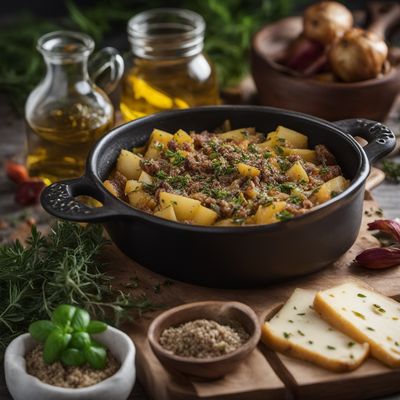
Ingredient
Cheese, pecorino toscano
The Quintessential Tuscan Cheese: Pecorino Toscano
Pecorino Toscano is a semi-hard cheese made from sheep's milk. It has a pale yellow color and a firm, slightly crumbly texture. The cheese has a nutty and savory flavor with hints of grass and herbs. Its aroma is earthy and slightly pungent. Pecorino Toscano is often aged for several months, which intensifies its flavor and gives it a more complex profile. It is a versatile cheese that can be enjoyed on its own, grated over pasta, or used in various recipes.
Origins and history
Pecorino Toscano originated in the Tuscany region of Italy, where it has been produced for centuries. The cheese has deep roots in Tuscan culture and is closely tied to the region's pastoral traditions. It was traditionally made by shepherds who used sheep's milk to create a cheese that could be easily preserved and consumed during long periods of transhumance. Today, Pecorino Toscano is recognized as a Protected Designation of Origin (PDO) cheese, ensuring its authenticity and adherence to traditional production methods.
Nutritional information
Pecorino Toscano is a nutrient-dense cheese, rich in calcium, protein, and phosphorus. It is also a good source of vitamins A and B12. A 1-ounce (28g) serving of Pecorino Toscano provides approximately 110 calories.
Allergens
Pecorino Toscano contains milk and is not suitable for individuals with lactose intolerance or milk allergies.
How to select
When selecting Pecorino Toscano, look for a cheese that is firm and free from any mold or discoloration. Opt for a cheese that has been aged for at least a few months for a more pronounced flavor. If possible, choose a cheese that has been produced using traditional methods and is labeled with the PDO designation.
Storage recommendations
To maintain the freshness and quality of Pecorino Toscano, it is best stored in the refrigerator. Wrap the cheese tightly in wax paper or plastic wrap to prevent it from drying out. It is important to keep the cheese away from strong-smelling foods as it can absorb odors easily. Properly stored, Pecorino Toscano can last for several weeks.
How to produce
Pecorino Toscano is typically produced by experienced cheesemakers using sheep's milk. The process involves curdling the milk, draining the whey, and pressing the curds into molds. The cheese is then salted and aged for a period of time to develop its unique flavor and texture. Producing Pecorino Toscano at home requires specialized equipment and knowledge, making it more suitable for professional cheesemakers.
Preparation tips
Pecorino Toscano can be enjoyed in various ways. It can be served on a cheese board alongside fruits, nuts, and honey for a delightful appetizer. Grated Pecorino Toscano adds a distinctive flavor to pasta dishes, risottos, and salads. It can also be melted over grilled vegetables or used as a topping for pizzas. For a traditional Tuscan treat, pair Pecorino Toscano with a glass of Chianti wine.
Substitutions
If Pecorino Toscano is not available, you can substitute it with other types of pecorino cheese, such as Pecorino Romano or Pecorino Sardo, which have similar characteristics and flavors.
Culinary uses
Pecorino Toscano is a versatile cheese that can be used in a variety of culinary applications. It is commonly grated over pasta dishes like spaghetti carbonara or used as a key ingredient in traditional Tuscan recipes such as Pappa al Pomodoro (tomato and bread soup) or Panzanella (bread salad). It can also be enjoyed on its own, paired with fruits, nuts, and a glass of wine.
Availability
Pecorino Toscano is primarily available in Italy, particularly in the Tuscany region where it is produced. It can also be found in specialty cheese shops and gourmet food stores worldwide.
More ingredients from this category » Browse all

Cheese, monte veronese
The Italian Gem: Monte Veronese Cheese

Cheese, mahon
The Quintessential Taste of Mahon: Exploring the Richness of Mahon Cheese

Cheese, emmental
The King of Swiss Cheeses

Cheese, coolea
Coolea Cheese: A Taste of Irish Craftsmanship

Cheese, murcia
The Tangy Delight: Murcia Cheese

Cheese, canestrato pugliese
Canestrato Pugliese: A Taste of Puglia's Rich Cheese Heritage

Cheese, montasio
The Alpine Delight: Exploring the Richness of Montasio Cheese

Cheese, castelmagno
The King of Piedmont: Castelmagno Cheese

Cheese, majorero
Majorero: The Flavorful Cheese from the Canary Islands

Cheese, gruyere
Gruyere: The Quintessential Swiss Cheese

Cheese, roncal
The Quintessential Spanish Delight: Roncal Cheese

Cheese, aged graviera
Savory Greek Delight


